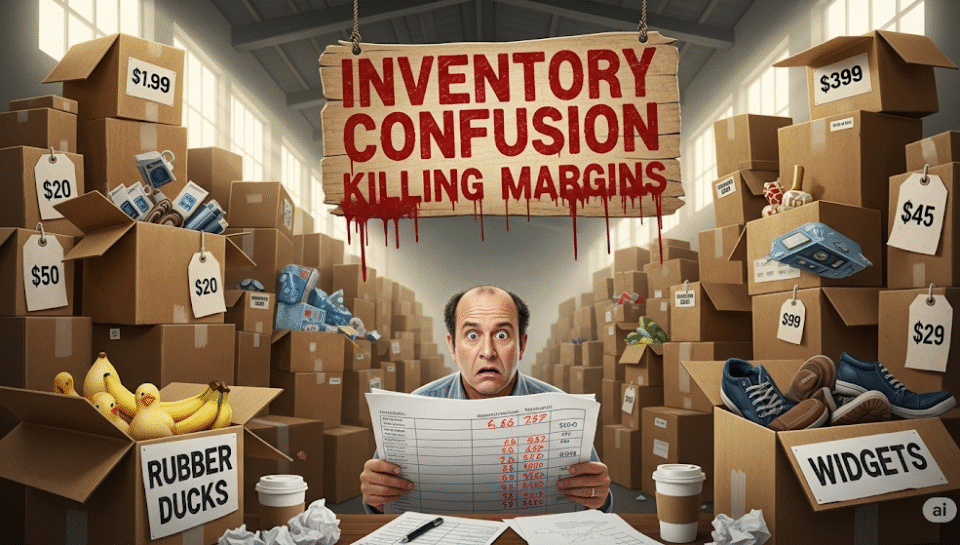Ever walk through your warehouse and wonder if your inventory numbers are as slippery as the shop floor on a rainy day? You’re not alone. In manufacturing, inventory confusion isn’t just a headache—it’s an invisible thief, stealing your profits, wreaking havoc on job costing, and making your end-of-month close feel like a crime scene investigation.
Let’s break down why cleaning up your inventory accounting matters, the real-world risks of muddled stock records, and practical steps that will get your margins back on track (and might just help you sleep better at night).
Inventory Confusion: More Expensive Than Lost Tools
You wouldn’t ignore a missing drill, but ignoring inaccurate inventory tracking is even costlier. Here’s where the real damages creep in:
1. Overordering & Stockouts
Without an up-to-date handle on what you have, you either overbuy (hello, cash tied up in unused parts) or run out at the worst possible time (cue production delays and frustrated customers). It’s a lose-lose for both your working capital and your client relationships.
2. Murky Margins
If your inventory system can’t give a true cost of goods sold, your gross margins might look better than they are. You may set prices based on faulty assumptions, putting you at risk of underbidding jobs or losing out on valuable revenue.
3. Ineffective Job Costing
Accurate job costing is impossible with mystery inventory. Suddenly, you’re “estimating” (read: guessing) at project profitability, rather than knowing.
4. Cash Flow Crunches
Too much cash in supplies, or missed billing for what’s been used, can leave your accounts tighter than a jammed shop door just when you need to make payroll or pay vendors.
5. Audit & Compliance Woes
When your books don’t match what’s on your shelves, audits become a horror story—and can lead to fines, penalties, or lost lender confidence.
The Signs Your Manufacturing Business Has an Inventory Problem
- You “find” boxes of parts months after you ordered them.
- Your team is surprised by stockouts or overstocked shelves.
- Reconciling inventory with your accounting system takes days (and aspirin).
- Unit costs are always “estimated”—not known.
- No one is sure if the physical count will match the year-end report. Spoiler: It won’t.
How Manufacturers Can Fix Inventory Confusion
Fortunately, with a few process tweaks—and the right financial partner—you can get inventory under control fast.
Step 1: Regular Physical Counts
Institute monthly or quarterly inventory checks, matching what’s on your shelves with your bookkeeping records. Train your team that “close enough” isn’t good enough.
Step 2: Use the Right Tools
Invest in inventory management software that syncs with your accounting system. Manual spreadsheets are okay for grandma’s cookie recipes, but not for modern manufacturing. With the right technology, incoming and outgoing stock updates instantly, reducing errors.
Step 3: Connect Bookkeeping & Operations
Ensure your operations manager and bookkeeper talk as much as your shop foreman and supply vendor. Inventory entering or leaving your facility should get logged both physically and financially, ideally in real time.
Step 4: Monitor Key Metrics
Watch for these canary-in-the-coal-mine indicators: Excessive adjustments, frequent rush orders, and unexplained variances in cost of goods sold. Catching problems early saves money and headaches.
Step 5: Review and Adjust SOPs
Standardize how inventory is received, moved, and used. Every part, from screws to major assemblies, should be accounted for. Hold your team accountable for following these standards—no more “creative counting.”
The Benefits: What’s In It for Your Bottom Line?
When you take control of your inventory accounting, you unlock:
- True Job Costing: Price confidently, win better contracts, improve profitability.
- Stronger Cash Flow: Free up cash by avoiding overbuying, and bill faster with real-time usage data.
- No More Year-End Surprises: Make audits and tax time a breeze—no more mysterious write-offs.
- Informed Decision Making: Use accurate data to plan, grow, and invest with confidence.
Final Thoughts (and a Friendly Nudge)
If “inventory reconciliation” gives you flashbacks to your worst production days, you’re overdue for a checkup. Getting a handle on your inventory doesn’t require a PhD in logistics—just better processes, an honest review, and a willingness to modernize.
Or if you’re ready to delegate, SkillBench specializes in organizing manufacturing books (and yes, inventory nightmares too). You focus on making quality products; we’ll make sure your inventory numbers are as precise as your machining.
Remember: In manufacturing, losing track of inventory is like misplacing your tools—except way more expensive. Let’s clean up your books, protect your margins, and finally put those sleepless nights to rest.




